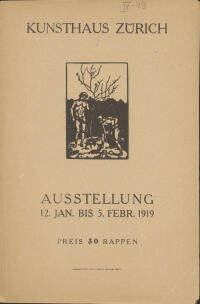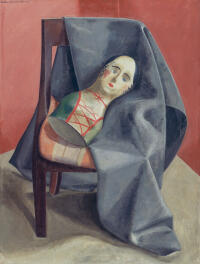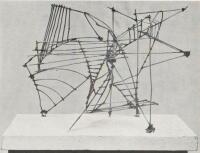Schweizerische Expressionisten «Das Neue Leben». Oskar Lüthy, K. F. Zähringer
12.01.1919 – 05.02.1919
Curated by Fritz Cäsar Baumann.
Location Moser-Bau.
Curated by Fritz Cäsar Baumann.
Location Moser-Bau.
The attribute 'new' needs to be seen as the anticipation of a mood intended to characterize the innovative spirit of the 1920s with such denominations as 'Neue Sachlichkeit' (New Objectivity) and 'Esprit Nouveau' (New Spirit).
'We are not only artists but also people, and we feel obligated to again become a force in life with a positive effect. […] The exhibition shows attempts to bring art back into life. You will see many newly treated materials and almost no "pictures’"in the conventional sense.' With these words, Marcel Janco laconically brings to a head what mattered about the movement 'The New Life', freely founded around Fritz Baumann and claiming to establish itself as a new group of artists. The attribute 'new' needs to be seen as the anticipation of a mood intended to characterize the innovative spirit of the 1920s with such slogans as 'Neue Sachlichkeit' (New Objectivity) and 'Esprit Nouveau' (New Spirit). In formal terms, the list of artists includes such varied positions as that of the French artist Francis Picabia and those of the two Romanians Tristan Tzara and Marcel Janco, who are surprisingly called 'Swiss Expressionists' in this connection, which, however, is accurate when one considers that they were resident in Switzerland at the time of the exhibition. The exhibition covered 249 works from 24 artists, including nine women. It had already been seen in the Kunsthalle Basel in November 1918, and there were later shows with the same title and similar claims, such as the one in the Kunsthalle Bern from 14.1. to 8.2.1920. For the Zurich exhibition two small catalogs were published with all the exhibited works and black-and-white reproductions of Fritz Baumann, Hans Arp, Augusto Giacometti, Marcel Janco, Oskar Lüthy, Otto Morach, Niklaus Stoecklin and Sophie H. Taeuber. Purchases were made for the Kunsthaus Zürich from works that were on sale, including Niklaus Stoecklin’s 'Perückenstock' (Wig Stick, 1917, see link). In general, the art critics were well disposed to the exhibition; the production of an analogy between politics and art is remarkable in that context.
[Cathérine Hug]
Further information
'As in political life, there is a storm currently raging through the kingdom of art, which wants to bring down everything that has had roots until now, to make room for a new kind of art. "New Life" should flourish from the ruins.'Winterthurer Tagblatt, 4.2.1919
24 days
23 Artists
23 Artists

1/2
exhibition catalog

2/2
exhibition catalog
1/2

